
Clementinum (Klementinum) is a large historical complex of Baroque buildings in Prague, which was a former Jesuit college, and today it is the home of the National Library of the Czech Republic, which anyone can visit.
The Clementinum was built, acquired its current size and features in stages. The history of its origin dates back to the 11th century.
It was the first hostel in Prague, where the Jesuits arrived in 1556. Ferdinand I called them to Prague to help him in his efforts against the Reformation. Upon arrival, they settled in the former Dominican monastery of St. Clement in the Old Town at Charles Bridge.
The full-fledged complex was built from the mid-16th to the mid-18th century, originally as a Jesuit college.
Today in the Clementinum complex you can visit: beautiful baroque library hall, Meridian Hall with a collection of astronomical instruments, see a facsimile of the Visegrad Codex and climb to the observation deck of the astronomical tower, which offers panoramic views of Prague. You can visit these objects of the Clementinum with an excursion. Also, as part of the tour, you can look into The Mirror Chapel of the Clementinum, but only if no other events are taking place in the chapel at this time.
The complex also includes: St. Clement's Cathedral (Katedrala sv. Klimenta), Chapel of the Assumption of the Blessed Virgin Mary (Vlas or Italian Chapel) and church of St. Salvator (Blessed Saviour, kostel Nejsvětějšího Salvatora).
The Clementinum has courtyards with a historical fountain and sculptures, including:
- A statue of a Prague student by Josef Max from 1847, which was erected in memory of the students who defended Prague from the Swedes in 1847;
- the vineyard courtyard, in the middle of which there is a stone fountain in the early Baroque style, which is a remnant of the first water supply system in Prague, built by the Jesuits. Between the windows of the upper floor there are six antique sundial, seven more are located in other places of the Clementinum complex. Thus, Clementinum has 13 hours of sunshine;
- in the last yard, which is to the side Marianske Square (Marianske naměstí), there is a monument to the director of the local observatory and astronomer Josef Stepling in the form of a Cupid with an Ignaz Platzer telescope.
You can enter the courtyards of the Clementinum through portals in the facades of the complex. Entrance to the courtyards is free.
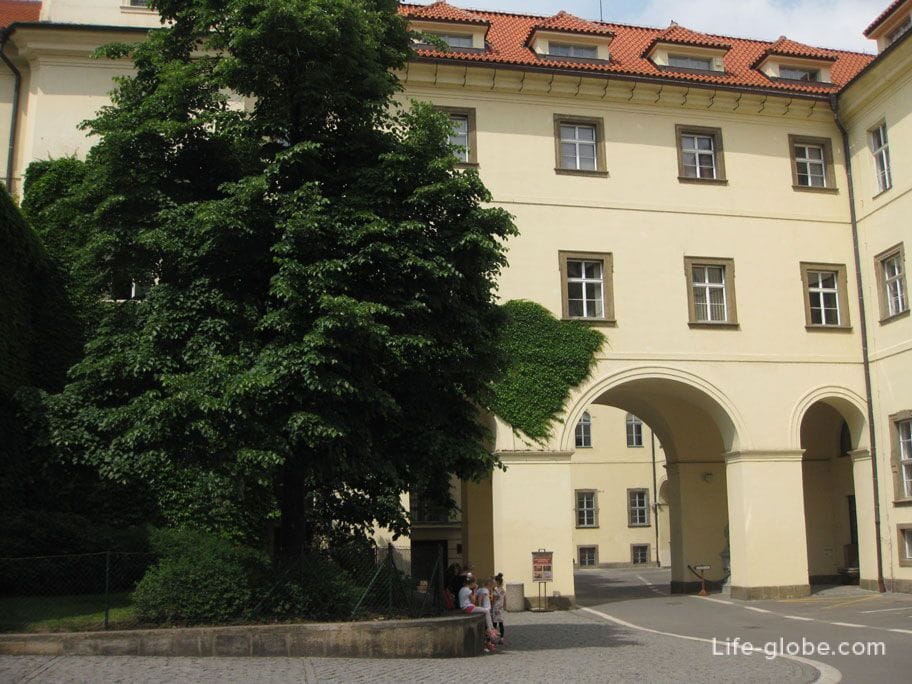
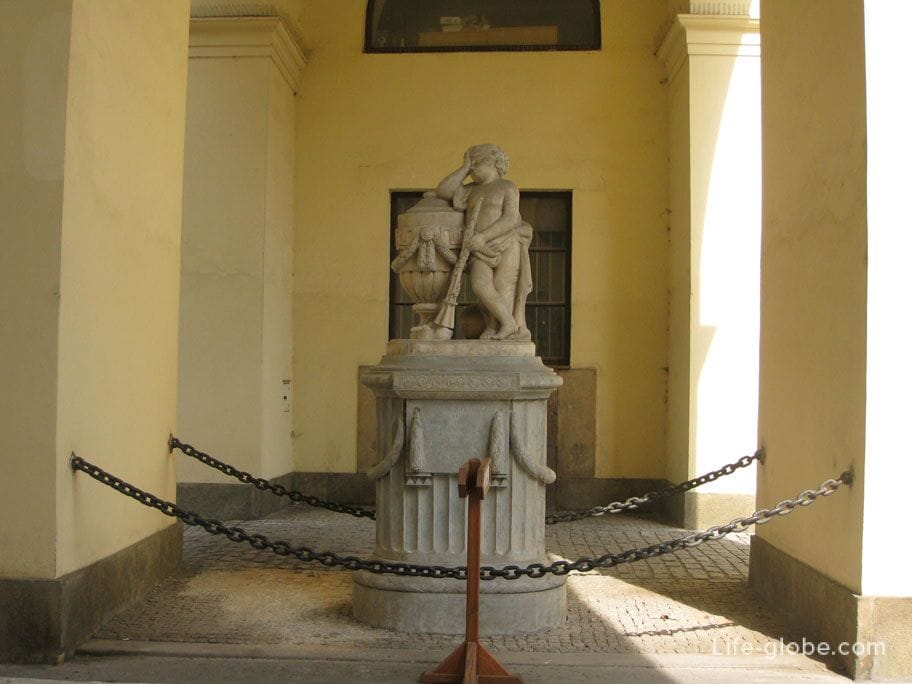
The Baroque library hall, the Meridian Hall, which used to accurately determine noon, and the astronomical tower with a height of 68 meters, which offers a beautiful view of the historical center of Prague in all directions, can only be visited with guided tours of the Clementinum. During the tour, you can also see a facsimile of the Visegrad Codex and look into the Mirror Chapel, if no other events are taking place in the chapel at this time.
Each tour lasts about 50 minutes and is conducted exclusively with a guide. Excursions are conducted in Czech and English.
Entrance to the tour is through the courtyards of the Clementinum, which is near the Astronomical Tower. There are also ticket offices where you can buy tickets.
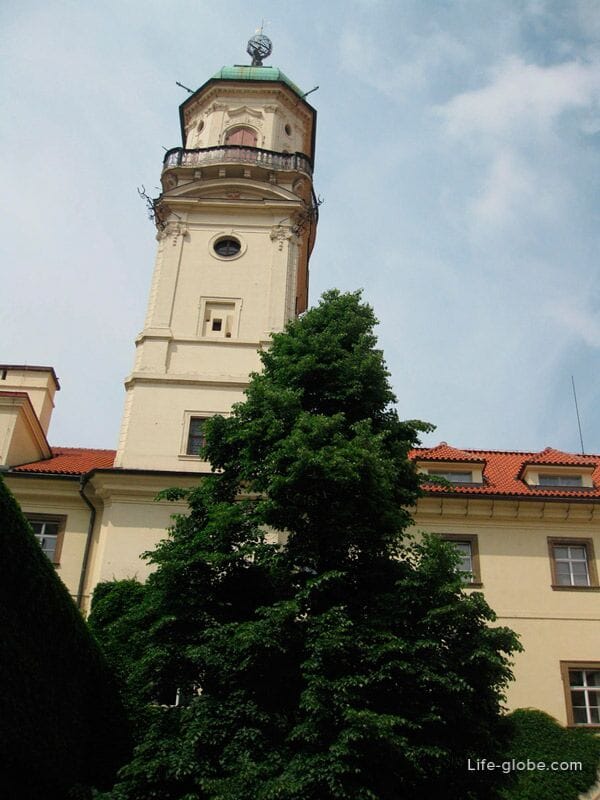
Since entrance to many places in Prague is paid, even to some churches and temples, we, approaching the ticket offices, already out of habit said that we had two students (in fact, we have not been students for a long time). We were practically not required to present student tickets anywhere, so it was rolling. In any case, it's worth a try. That's what we did in Clementinum - they came up and said, "Two students," and they punched us tickets at discounted prices without words.
Going into the hall, we see an exhibition copy. We didn't understand exactly what it was, but it looks like the mechanism of some kind of clock or something like that.
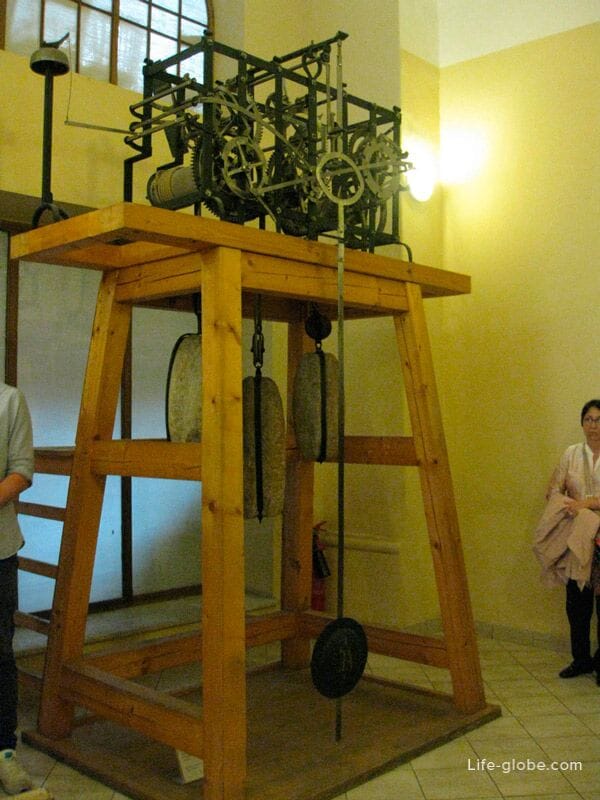
Then we move up the spiral staircase of the astronomical tower. We get into the lobby in front of the Baroque library hall.
In the lobby there are copies of old books, paintings, some furniture and other paraphernalia.


The pride of the hall is a facsimile Visegrad Code.
This book is rather large and is a collection of the gospels and religious texts, and contains 108 richly illustrated parchment sheets, a total of 26 pages of which with images of the evangelists, the "family" of Christ and images from the Old Testament, as well as the Czech patron - Vaclav.
The Codex is written in Latin and is considered the most famous and valuable manuscript in the Czech Republic. The Visegrad Codex was compiled presumably on the occasion of the coronation of the first Czech king Vratislav II in 1085 in Prague Castle, where it was presented to the king.
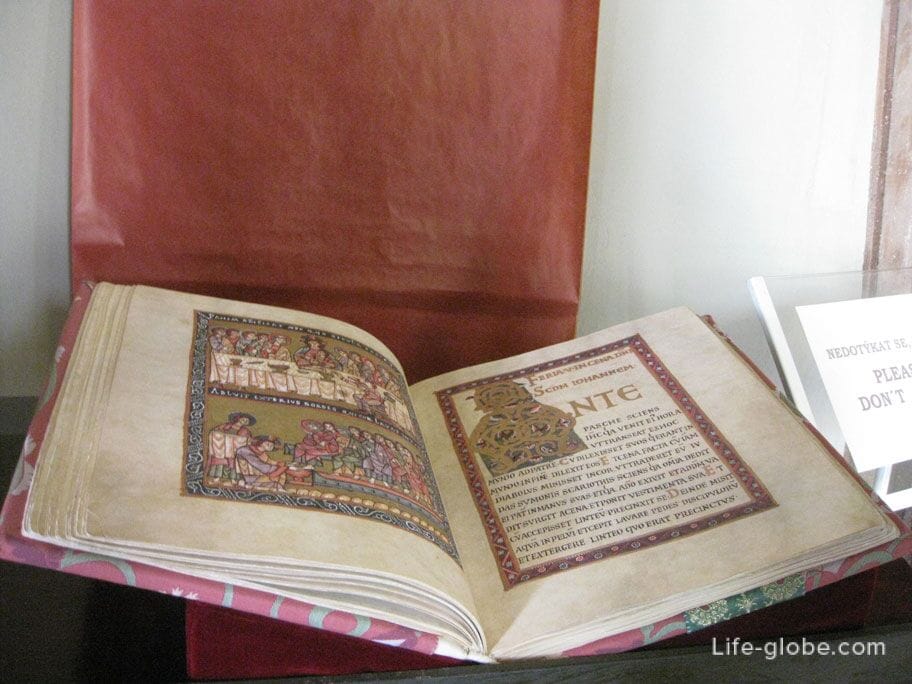
In the lobby hall we see a beautiful door. This door leads to one of the most beautiful library halls in the world - the Baroque hall of the library Clementinum.
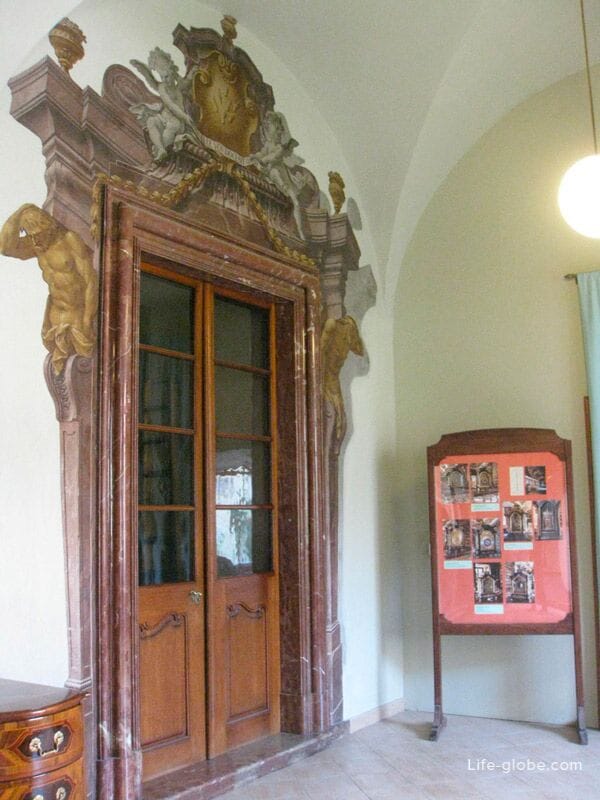
The guide opens the door and we see the hall of one of the most beautiful libraries in the world. It is forbidden to shoot in the hall, the guide and the camera on the ceiling are watching this. We filmed secretly, from under the arm, on the phone.
In the photo on the Internet, the hall looked quite impressive, but in fact it turned out to be not so big and quite narrow, but this does not spoil its wonderful atmosphere at all. The hall smells of old books and is in semi-darkness.
The exterior of the hall has been preserved since the 18th century. The hall is decorated with beautiful frescoes by Jan Hibla, on the theme of art and science with images of allegorical motifs, as well as figures of Jesuit saints, patrons of the university and important representatives of the Jesuit order. The hall contains a collection of foreign-language printed theological literature, a large portrait of Emperor Joseph II, presumably made in 1783, and several historically valuable large astronomical and geographical globes.

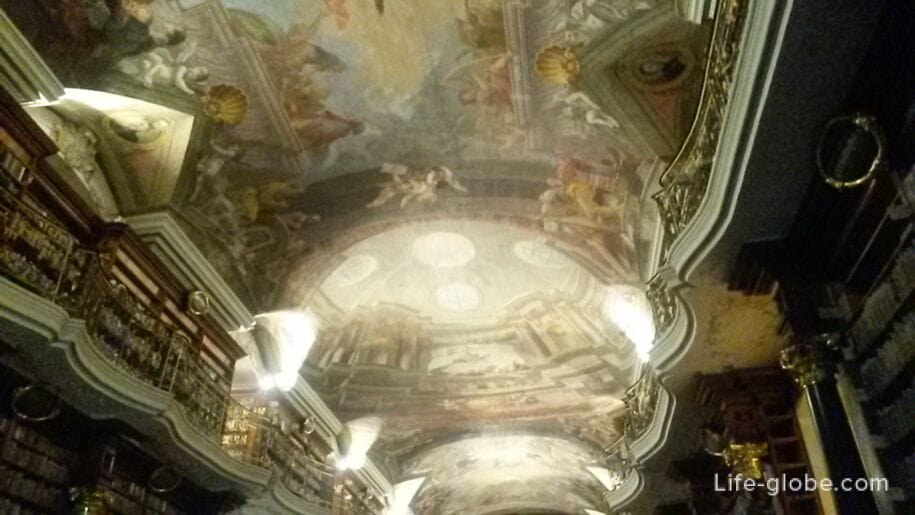
You cannot go into the Baroque hall of the library itself and walk around it. You can only stand and inspect the hall at the open door. As we were told, everyone is not allowed to enter the hall, except for researchers and students with special passes. The fact is that the books collected in this hall are very old and require special careful care. In total, about 20,000 volumes of books are collected in the hall, all of them are placed on high shelves from floor to ceiling on both sides of the hall. More about the Baroque hall of the Clementinum…
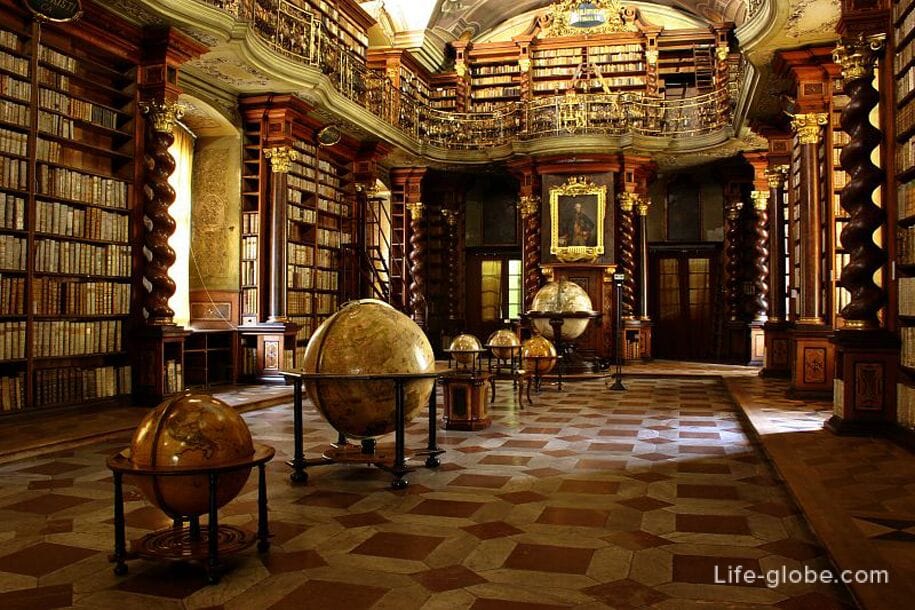
We leave the lobby of the Baroque library hall and move up the spiral staircase again. Yes, by the way, you can not go up the stairs, but take the elevator, but we did not use the elevator, because the stairs are more interesting.
Climbing the stairs, we get to the Meridian Hall (Meridiánovou sín) Clementinum, located on the 2nd floor of the astronomical tower.
The name of the hall "meridian" comes from the phrase "Prague meridian". This hall is in semi-darkness.
All meteorological measurements are carried out in Clementinum to this day, which makes it one of the oldest in the world of this kind.
Initially, it was an observatory, where, in addition to astronomical and meteorological observations, physical experiments were also carried out in the study. In the first half of the 19th century, Earth's magnetism and atmospheric ozone were measured from here.
The original astronomical instruments have been preserved in the walls of the Meridian Hall.
The string, protected by a wooden cabinet, is on the floor. There is a small hole in the left wall - a camera obscura (from the Latin word "camera obscura", which translates as "dark room"). Through this hole in the wall, a sunbeam enters the room, which gradually moves around the hall, and at the moment when it turns out to be cut by the meridian string, which is on the floor, strictly in half, means that it is noon.
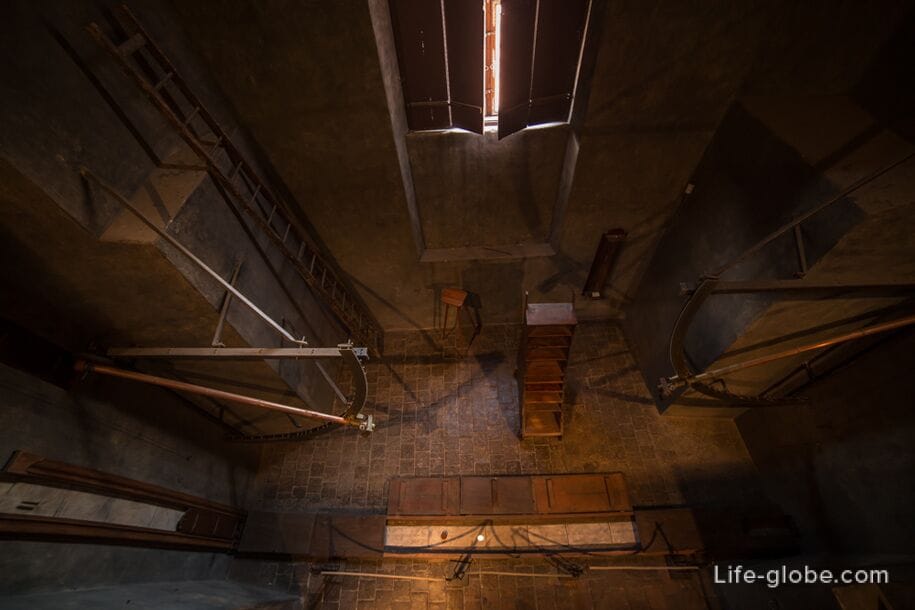
In past centuries, for a long time, only in this way was a signal sent from the Clementinum indicating the onset of noon. Since 1842, the signal was given using flags. The signal given in the form of a flag was most often followed by a shot from a cannon from the bastion of St. Magdalene. Thus, the midday signal was given until 1928. The job of looking after the beam at that time was responsible and requiring special attention and perseverance, from which it was considered respected, because only in this way, many citizens could know for sure whether it was noon.
In addition, there are two original wall quadrants in the meridian hall, presumably by Jan Klein. The quadrant is a device that was used to determine the zenith distances of the luminaries.
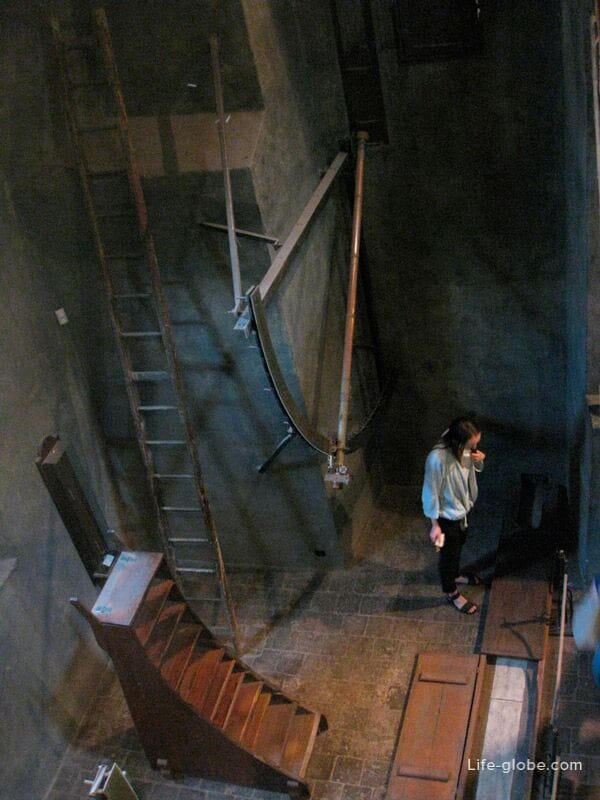

After the meridian hall, we climb up the wooden stairs to the observation gallery (platform) of the Astronomical Tower of Clementinum.
The tower can be reached by elevator only up to the 3rd floor, from where there are 87 more steps to the observation gallery of the tower.

Climbing the stairs, we get into a round room, to the very top of the Astronomical Tower of Clementinum. The astronomical tower was built in 1722. Its height from the base to the observation deck is 52 meters. And the total height of the tower is 68 meters. When climbing to this very top, we overcame a total of 172 steps. At the very top, the tower is decorated with a sculpture of an Atlas bearing a celestial sphere.
There are also several exhibits in this hall.
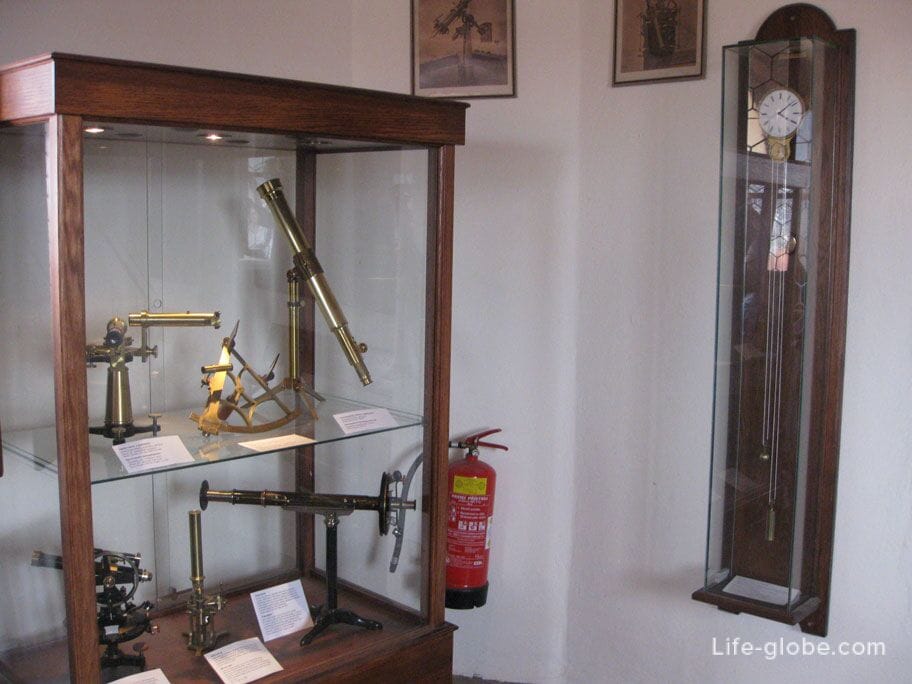

The guide opens the doors and we go out to the gallery of the tower - to the observation deck of the Astronomical Tower, which is one of the best sightseeing points of Prague.
The views of Prague from this height are simply magical - red tiled roofs and narrow streets of Old Prague are everywhere. We plunge into these views with our heads, walk around the circle of the site and look - look…

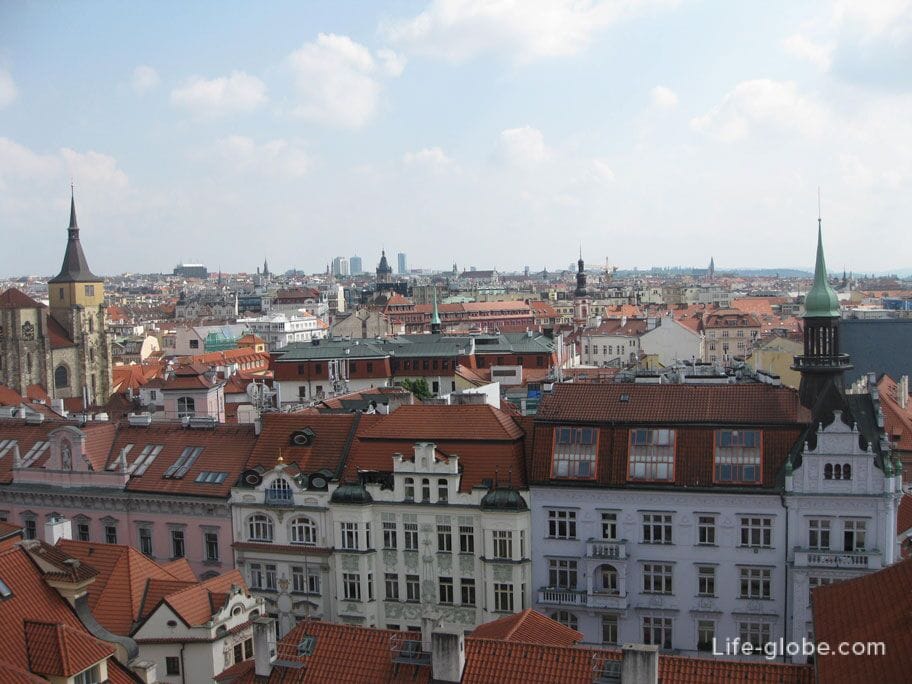
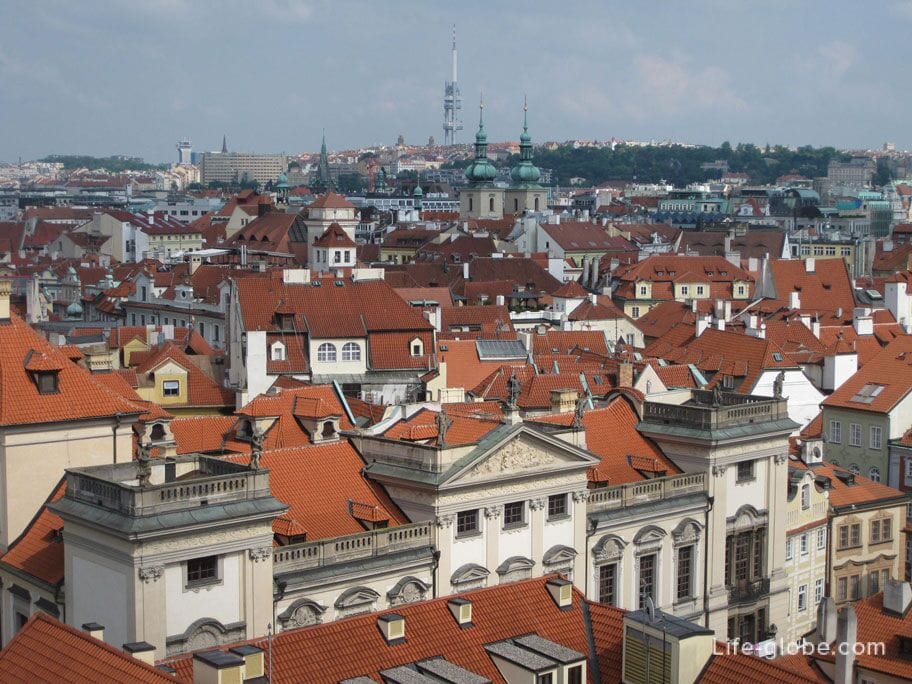
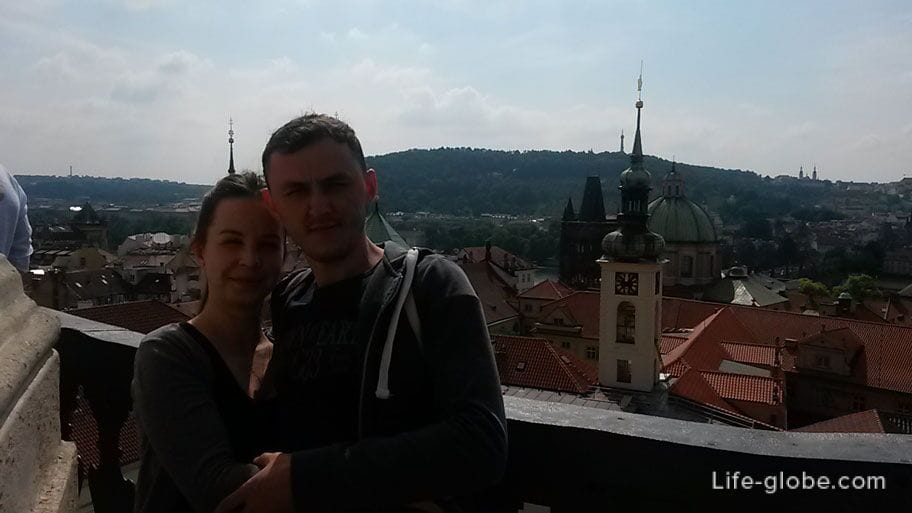
Here is the towering Tyn Temple and domes st. Nicholas church on Old Town Square

View of the Tyn temple and Old Town Hall on Old Town Square

And on the other side of the observation deck in the distance you can see Prague Castle
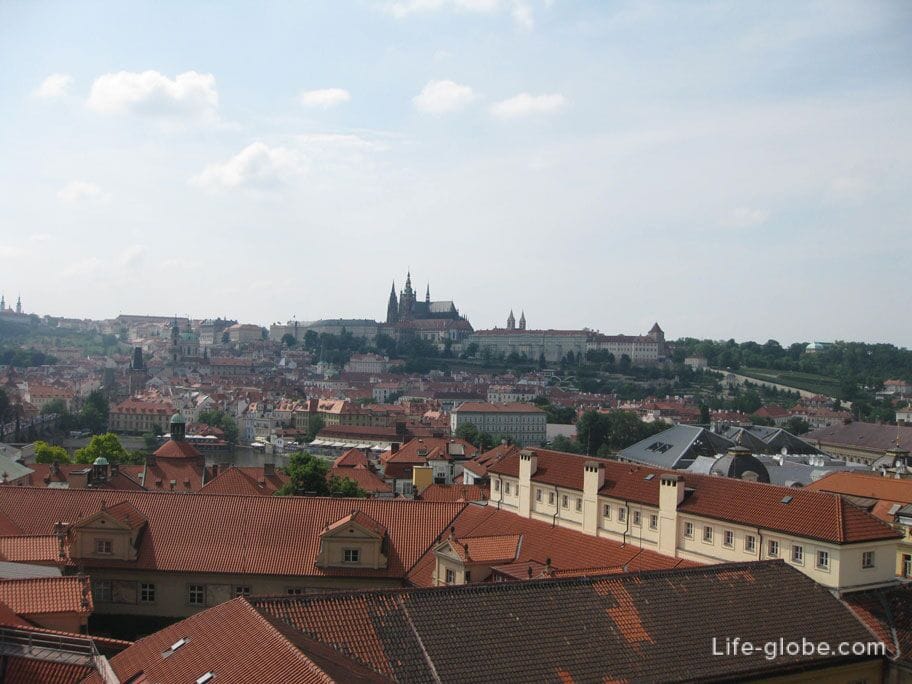
The Clementinum complex itself with courtyards is clearly visible from above
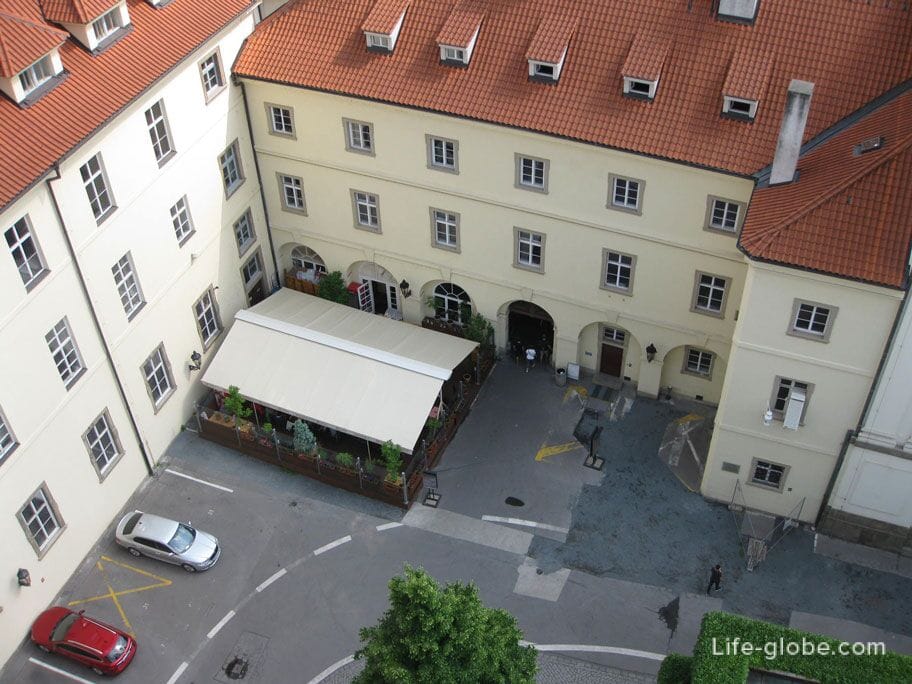

A couple of panoramic shots from the observation deck of the Astronomical Tower of Clementinum


This is where our tour of the Clementinum came to an end, we went down and came out on the historical Charles Street The Old City of Prague, which is part of The Royal way through the city.
We did not manage to look into the Mirror Chapel of the Clementinum during the tour, an event was held there.
You can find out detailed information about excursions in Clementinum, as well as the time of excursions, the cost and purchase a ticket on the official website: klementinum.com.
The Mirror Chapel or Chapel of the Annunciation (Zrcadlová kaple, Kaple Zvěstování Panny Marie) is a chapel in the high Baroque style in the Clementinum complex, which is considered a pearl among representative spaces.
The construction of the chapel was carried out in 1722-1726 at the expense of the Latin Congregation of the Great Mary and, probably, according to the project of architect Frantisek Maksmilian Kank or architect Kilian Ignaz Dinzengofer.
The current name of the "Mirror" chapel was received later, due to the presence of many mirrors in the decoration of the walls and vaults, which were donated to the chapel by the Imperial Lorio Foundation. It was thanks to such an ornate interior, coupled with excellent acoustics, that the chapel charmed not only many contemporary artists, but also V.A. Mozart himself, who, as they say, could not resist during a visit to the Clementinum and played the organ in the chapel with pleasure.
In addition to the mirrors, which are part of the frescoes, the chapel stands out with marble decoration and an original organ from 1732 by organist Tomasz Schwartz. Another organ was installed in the opposite part of the chapel on the site of the former main altar, which was stolen after the secularization of the building in 1784.
Today, the Mirror Chapel regularly hosts classical music concerts, exhibitions, wedding ceremonies and various events for which the chapel can be rented. There are also guided tours of the chapel. Excursions are paid.
Mirror Chapel Website: zrcadlovakaple.cz.
The mirror chapel is located in the fourth courtyard of the Clementinum on the ground floor of the wing that connects the Astronomical Tower with the northern wing of the dormitory on Platnéřská Street. More about the Mirror Chapel of Clementinum…

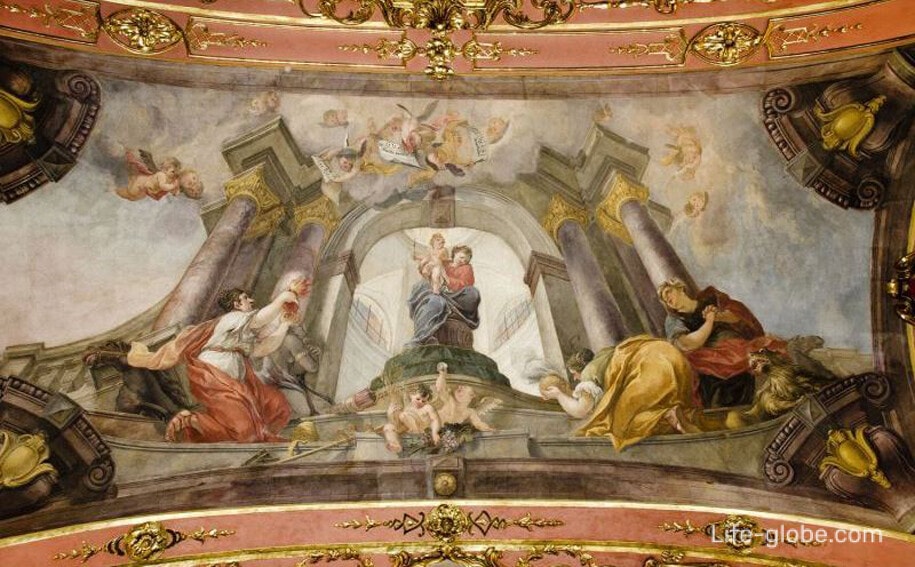
In addition to the objects listed above, the Clementinum complex also includes two churches and an Italian chapel, which can be visited separately from other objects and for free.
Cathedral of St. Clement or Clementinum Catedral (Katedrála sv. Klimenta) is a Greek Catholic church with a delightful Baroque interior, which hosts concerts of chamber classical music.
The church was built for the Jesuits between 1711 and 1715 by architect F.M. Kanka builder Anselm Lurazh. The construction of the church was carried out on the site of the Romanesque church of St. Clement.
Bright frescoes, stucco decoration and sculptural decoration stand out in the interior of the cathedral. The main altar, painted with an illusory painting, is dominated by the image of St. Clement and St. Ignatius of Loyola.
St. Clement's Cathedral website: exarchat.cz. More about St. Clement's Cathedral…


The Church of St. Clement has a common entrance portico with the chapel of the Assumption of the Virgin Mary (Vlašská kaple Nanebevzetí Panny Marie ), better known as the Italian Chapel (Vlaška Chapel), which was built between 1590 and 1600 for Catholics -Italians.
The interior of the chapel is decorated in Baroque style, and its dome is decorated with a monumental fresco "Assumption of the Virgin".
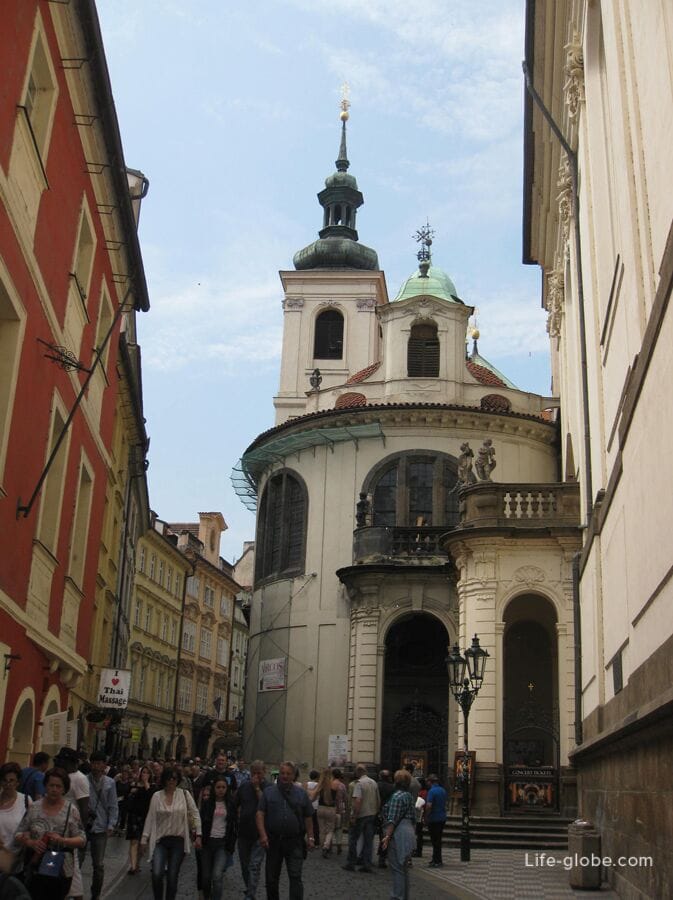
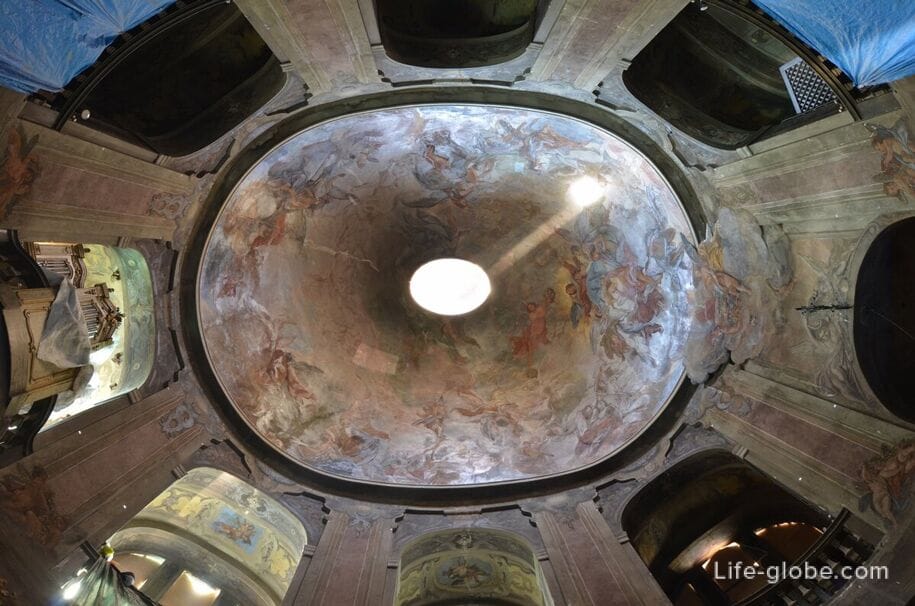
Church of St. Salvator or the Church of the Blessed Saviour (Church of the Most Holy Salvator), the facade of which faces Krzyzhovnitska square (Crusader Square, Křižovnické náměstí), directly opposite the famous Charles Bridge (Karlův most), spanned by the Vltava river.
This church is considered one of the most valuable architectural monuments of the early Baroque in Prague.
The portico gallery and the pediment of the church are decorated with large life-size sandstone statues: the fathers of the church on the balustrade, the holy orders on the side wings of the shield, the Virgin Mary in a niche in the middle of the shield, the four Evangelists above the tympanum and Christ in the uppermost part of the facade.
The interior of the church in the early Baroque style is distinguished by rich stucco decoration and statues. In the underground crypt there is a burial ground of members of the Jesuit Order, including the defender of the Czech language Bohuslav Balbin.
The church is open to visitors half an hour before the services. Individual visits are possible by agreement.
Website of the Church of St. Salvator: farnostsalvator.cz. More about the Church of St. Salvator…
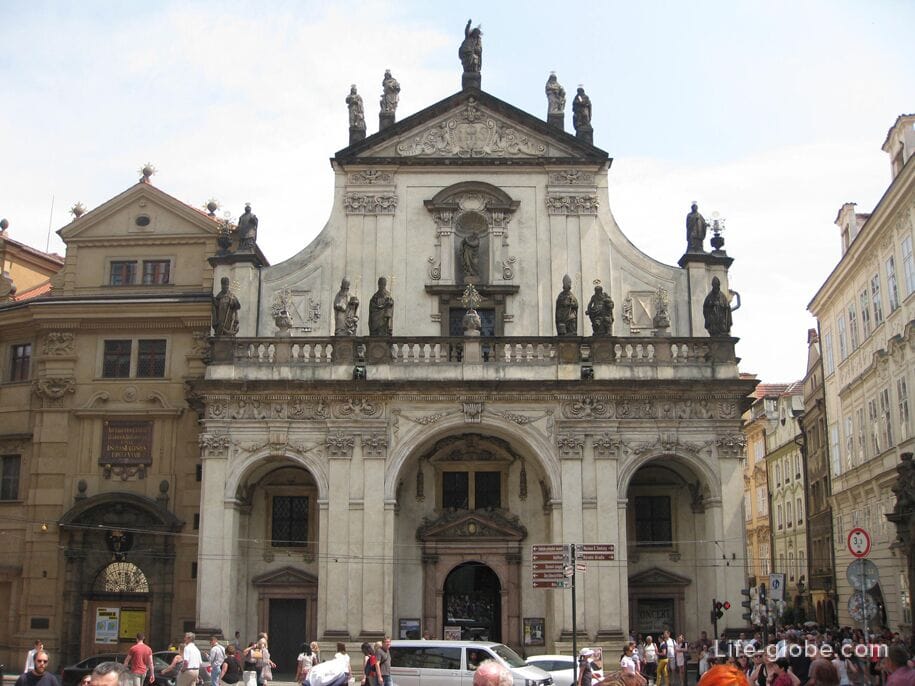
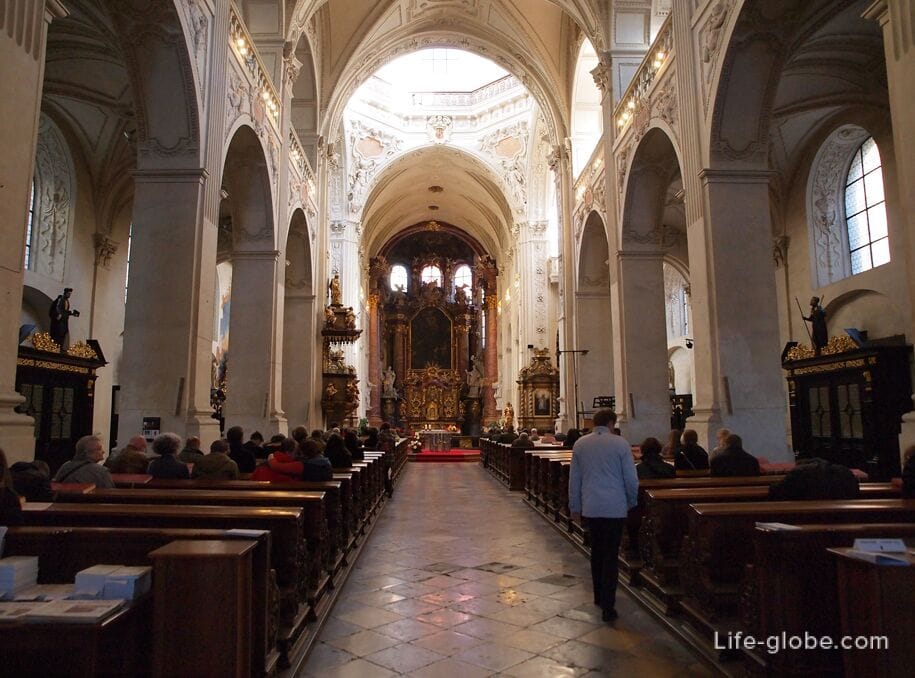
Most of the Clementinum is occupied by the National Library of the Czech Republic.
Exhibitions are held in the library from time to time.
National Library Website: nkp.cz.
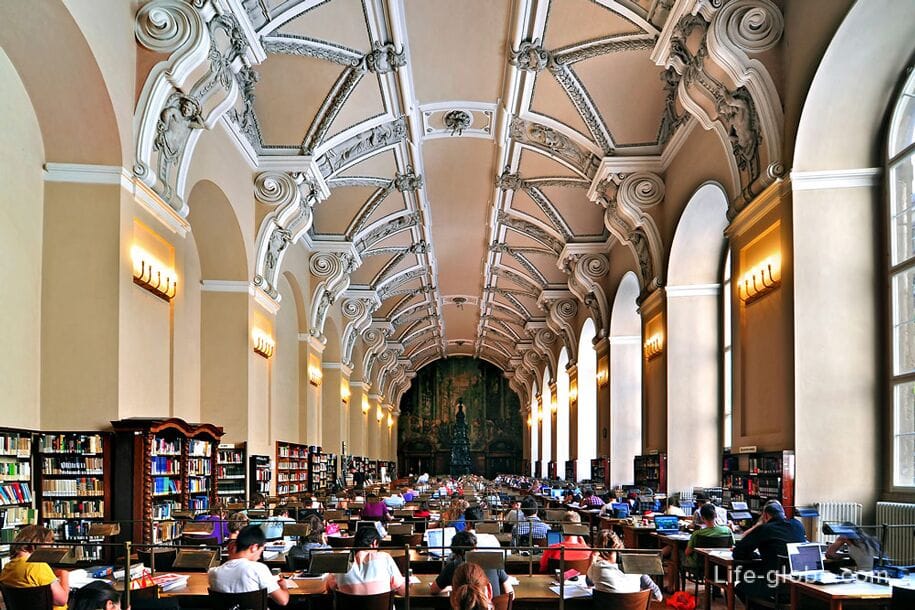
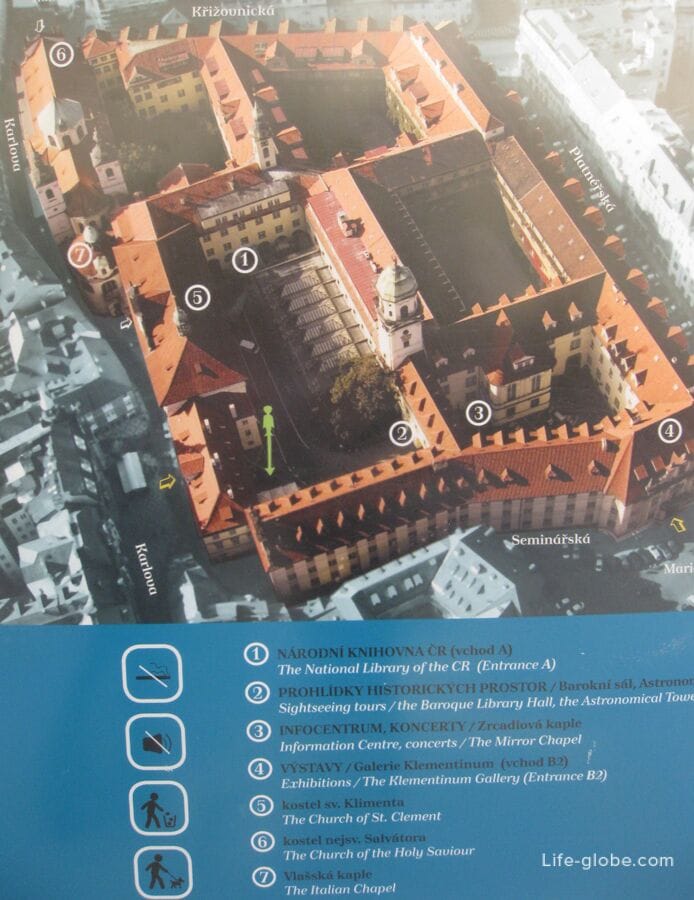
The Klementinum is located in the historical center of Prague, in the Staré Město district, at address: Mariánské nám. 5, 110 00 Staré Město, Czech Republic.
Coordinates of the Clementinum: 50°05'12.0"N 14°24'59.0"E (50.086667, 14.416389).
All accommodation facilities in Prague (hotels, apartments, guest houses, etc.), including in the historical center of the city and more remotely from it, can be view and book here